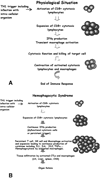Pediatric hemophagocytic syndromes: a diagnostic and therapeutic challenge
- PMID: 20529219
- PMCID: PMC2877072
- DOI: 10.1186/1710-1492-1-4-142
Pediatric hemophagocytic syndromes: a diagnostic and therapeutic challenge
Abstract
Pediatric hemophagocytic syndrome (HS) is a severe and often fatal clinical disorder. This syndrome is frequently unrecognized, and thus, affected children may receive suboptimal management, leading to an increase in mortality. The purpose of this review is to provide a clinical guide to (1) the recognition of HS based on clinical, biologic, and pathologic features; (2) the identification of the primary cause of HS in a given affected child; and (3) the initiation of effective treatment in a timely manner.
Figures




Similar articles
-
Adult cancer-related hemophagocytic lymphohistiocytosis - a challenging diagnosis: a case report.J Med Case Rep. 2017 Jun 27;11(1):172. doi: 10.1186/s13256-017-1344-x. J Med Case Rep. 2017. PMID: 28651636 Free PMC article.
-
When T cells and macrophages do not talk: the hemophagocytic syndromes.Curr Opin Hematol. 2008 Jul;15(4):359-67. doi: 10.1097/MOH.0b013e3282f97f88. Curr Opin Hematol. 2008. PMID: 18536575 Review.
-
[Hemophagocytic syndrome: diagnostic problems].Przegl Lek. 2006;63(1):47-52. Przegl Lek. 2006. PMID: 16892901 Review. Polish.
-
High-Volume Hemofiltration in Critically Ill Patients With Secondary Hemophagocytic Lymphohistiocytosis/Macrophage Activation Syndrome: A Prospective Study in the PICU.Pediatr Crit Care Med. 2016 Oct;17(10):e437-e443. doi: 10.1097/PCC.0000000000000896. Pediatr Crit Care Med. 2016. PMID: 27487914 Clinical Trial.
-
Consensus recommendations for the diagnosis and management of hemophagocytic lymphohistiocytosis associated with malignancies.Haematologica. 2015 Aug;100(8):997-1004. doi: 10.3324/haematol.2015.123562. Haematologica. 2015. PMID: 26314082 Free PMC article.
Cited by
-
Hemophagocytic syndrome with atypical presentation in an adolescent.BMJ Case Rep. 2013 Sep 11;2013:bcr2013200929. doi: 10.1136/bcr-2013-200929. BMJ Case Rep. 2013. PMID: 24027258 Free PMC article.
-
Clinico-laboratory profile and perforin gene mutations of pediatric hemophagocytic lymphohistiocytosis cases: a five-year single center study.Pan Afr Med J. 2020 Aug 27;36:354. doi: 10.11604/pamj.2020.36.354.25079. eCollection 2020. Pan Afr Med J. 2020. PMID: 33224420 Free PMC article.
-
Debate around infection-dependent hemophagocytic syndrome in paediatrics.BMC Infect Dis. 2013 Jan 16;13:15. doi: 10.1186/1471-2334-13-15. BMC Infect Dis. 2013. PMID: 23324497 Free PMC article. Review.
-
[Macrophage activation syndrome complicating family lymphohistiocytosis].Pan Afr Med J. 2017 Feb 24;26:93. doi: 10.11604/pamj.2017.26.93.6235. eCollection 2017. Pan Afr Med J. 2017. PMID: 28491224 Free PMC article. French.
References
-
- Scott R, Robb-Smith A. Histiocytic medullary reticulosis. Lancet. 1939;2:194–8.
-
- Henter JI, Elinder G, Ost A. Diagnostic guidelines for hemophagocytic lymphohistiocytosis. The FHL Study Group of the Histiocyte Society. Semin Oncol. 1991;18:29–33. - PubMed
-
- Stephan JL, Zeller J, Hubert P. Macrophage activation syndrome and rheumatic disease in childhood: a report of four new cases. Clin Exp Rheumatol. 1993;11:451–6. - PubMed
LinkOut - more resources
Full Text Sources

